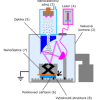Nanoprint from nanoparticles
Technology description
| The name of the technology: | Nanoprint from nanoparticles |
|---|---|
| Challenge: | Metal printing in 2D and 3D technology using additive manufacturing enables the rapid development of products that can have shapes that are unattainable for machine engineers. However, the disadvantage of current metal printing technologies is the resolution limited by the grain size of powders, from which, for example, laser sintering or melting the final product is created. At the same time, in this case, a large laser energy is needed. |
| Description: |
Our nanoprinting technology solves the disadvantage of the inadaptability of the micropowder by replacing it with nanoparticles. Compared to powder, nanoparticles also have an increased absorption of light and therefore it is possible to reduce the intensity of the laser beam that sinters / fuses these nanoparticles and thus reduce unwanted material casting near the exposed area. Until now, the technology of using nanoparticles for printing has been very difficult, as nanoparticles, which are supplied as standard in a liquid and stabilized by surfactants (active substance that reduces surface energy), are very difficult to transport to the point of laser exposure. Our technology solves this by integrating the production of nanoparticles directly into the device, where the nanoparticles are transported to the substrate in the form of a beam in a purity exceeding 99.99% in the gas phase, without the use of any added reagents. In addition, it is possible to change the features of nanoparticles during printing, such as their material composition, morphology and size. By its very nature, the device allows it to work without the presence of atmospheric gases in a vacuum and, accordingly, can not only prepare the product in almost unprecedented purity, but also combine this production method with other vacuum processes. |
| Commercial opportunity: | The technology improves the resolution, purity and material variability of production using 3D printing of metals and is therefore usable in areas specific to 3D printing (prototyping and final metal products). The technology allows 3D printing of metals on a very fine scale limited by the wavelength of light, which opens up application possibilities that are unattainable for classic 3D printing by the powder method. The technology can be used, for example, for the preparation of materials for development and research in biology and medicine - surfaces with variable topography for tissue engineering, scaffolds for osseointegration (implants), in electronics, microrobotics and optics for circuit printing, production of mechanical and electrical components and sensors. |
| IP protection status: | Utility model nr. 36570; CZ Patent application nr. 2022-444; PCT application in peparation. |
| Development status: |
Phase 3Corresponds with TRL 5 and TRL 6 Technology validation and implementing it in real environment. Testing the technology outside of the laboratory and its adjustment to external conditions.
|
| Partnering strategy: | licensing |
| More information: | |
| Images: | |
| Categories: | Nanotechnology Physics Hardware |
| Owner of a technology: | Jihočeská univerzita v Českých Budějovicích |

